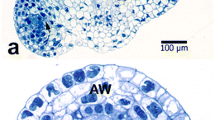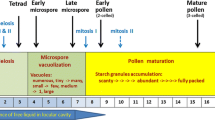Summary
1. Anther tissue and pollen grains of cytoplasmic male sterile and fertile wheat were studied with the aid of an electron-microscope for differences in cytoplasmic structures.
2. Clear and consistently occurring cytoplasmic differences were not observed, although unidentifiable particles were discovered in both the sterile and the fertile material.
3. Male sterility finds expression in the small number of organelles in the sterile pollen grains which consequently are little or hardly physiologically active and thus subject to a rather rapid degeneration. On the contrary the fertile pollen grains are full of cell organelles and therefore well equipped for a complete development.
4. The fertile pollen grain contains a clear intine which is thicker than the exine. Only a very thin intine was observed in the sterile material.
5. Male sterility has no visible influence on exine formation. Ubisch bodies occur in the anthers of both male sterile and fertile plants. There is no sign of any contribution to exine formation on the part of the Ubisch bodies. There was more evidence of exine formation from within than from without. The normality of exine formation of sterile pollen grains need not indicate exine formation from without; it suggests rather that exine is largely formed before degeneration.
Similar content being viewed by others
References
Borovskij, M. I., 1964. (The question of transmitting characteristics of pollen sterility from certain maize forms to others by non-sexual means). Bull. Acad. Sci. Moldav. SSR Ser. biol. chem. Sci. 10: 59–65 (Pl. Breed. Abstr. 39, 1969: 2322).
Carniel, K., 1968. Licht- und elektronenmikroskopische Untersuchung der Ubisch-körperentwicklung in der GattungOxalis. Österr. Bot. Zeitschr. 114: 490–501.
Catcheside, D. G., 1959. Cytoplasmic inheritance. Nature 184: 1012–1015.
Daskaloff, S., 1968. A male sterile pepper (C. annuum L.) mutant. Theor. Appl. Genet. 38: 370–372.
Echlin, P., 1968. Pollen. Scient. Amer. 218 (4): 80–90.
Edwardson, J. R., 1962. Cytoplasmic differences in T-type cytoplasmic male-sterile corn and its maintainer. Am. J. Bot. 49: 184–187.
Ephrussi, B., 1953. Nucleo-cytoplasmic relations in micro-organisms. Clarendon Press, Oxford, 127 pp.
Erickson, J. R., 1967. Biochemical investigations of cytoplasmic male sterility in spring wheat (Triticum aestivum L.). Agron. Abstr., Madison 1967: 8 (Pl. Breed. Abstr. 39, 1969: 2108).
Fukasawa, H., 1953. Studies on restoration and substitution of nucleus ofAegilotricum. I. Appearance of male-steriledurum in substitution crosses. Cytologia 18: 167–175.
Fukuhara, H., Faures, M. &Genin, C., 1969. Comparison of RNA's transcribed in vivo from mitochondrial DNA of cytoplasmic and chromosomal respiratory deficient mutants. Molec. Gen. Genet. 104: 264–281.
Hagemann, R., 1963. Advances in the field of plastid inheritance in higher plants. In: S. J. Geerts (Editor), Genetics today. Proc. XI. Intern. Congr. Genet., The Hague, The Netherlands. Pergamon Press pp. 613–625.
Hagemann, R., 1964. Plasmatische Vererbung. VEB G. Fisher Verlag Jena, 270 pp.
Heslop-Harrison, J., 1962. Origin of exine. Nature 195: 1069–1071.
Heslop-Harrison, J., 1968. Pollen wall development. Science 161: 230–237.
Jones, D. F., Stinson, H. T. &Uheng Khoo, 1957. Transmissible variations in the cytoplasm within species of higher plants. Proc. Nat. Acad. Sci. 43: 598–602.
Joppa, L. R., McNeal, F. H. &Welsh, J. R., 1966. Pollen and anther development in cytoplasmic male sterile wheat (Triticum aestivum L.). Crop Sci. 6: 296–297.
Kihara, H., 1951. Substitution of nucleus and its effect on genome manifestation. Cytologia 16: 177–193.
Lacadena, J. R., 1968. Hybrid wheat. VII. Tests on the transmission of cytoplasmic male sterility in wheat by embryo-endosperm grafting. Euphytica 17: 439–444.
Larson, D. A. &Lewis, C. W., 1962. Pollen wall development inParkinsonia aculeata. Grana Palyn. 3 (3): 21–27.
Marrewijk, G. A. M. van, 1968. Plasmatische mannelijke steriliteit en fertiliteitsherstel bij de petunia. Thesis Agr. Univ. Wageningen, 129 pp.
McWhirter, K. S., 1969. Male sterility inDesmodium. Austr. J. Agric. Res. 20: 227–241.
Mepham, R. H. &Lane, G. R., 1968. Exine and the role of the tapetum in pollen development. Nature 219: 961–962.
Millonig, G., 1961. A modified procedure for lead staining of thin sections. J. Biophys. Biochem. Cytol. 11: 736–739.
Ohta, Y., 1961. Grafting and cytoplasmic male sterility inCapsicum. Seiken Zihô 12: 35–39.
Ohta, Y., 1968. Effect of thermoshock and virus inoculation on cytoplasmic male sterility inCapsicum andPetunia. Ann. Rep. Nat. Inst. Genet. Japan 18 (1967): 26.
Palade, G. E., 1952. A study of fixation for electron microscopy. J. Exp. Med. 95: 285–298.
Pease, D. C., 1964. Histological techniques for electron microscopy. Acad. Press New York, London, 2nd ed., 381 pp.
Rhoades, M. M., 1933. The cytoplasmic inheritance of male sterility inZea mays. J. Genet. 27: 71–93.
Rhoades, M. M., 1950. Gene induced mutation of a heritable cytoplasmic factor producing male sterility in maize. Proc. Nat. Acad. Sci. USA 36: 634–635.
Risueño, M. C., Giménez-martin, G., Lopéz-Sáez, J. F. &R.-García, M. I., 1969. Origin and development of sporopollenin bodies. Protoplasma 67: 361–374.
Röbbelen, G., 1966. Zytogenetik des Plasmas. Deutsche Med. Wochenschr. 91: 715–720.
Rowley, J. R., 1962. Stranded arrangement of sporopollenin in the exine of microspores ofPoa annua. Science 137: 526–528.
Rowley, J. R., 1963. Ubisch body development inPoa annua. Grana Palyn. 4 (1): 25–36.
Rowley, J. R., 1964. Formation of the pore in pollen ofPoa annua. In: H. F. Linskens (Editor), Pollen physiology and fertilization. A symposium held at the University of Nijmegen, The Netherlands (North Holl. Publ. Comp., Amsterdam), pp. 59–69.
Skvarla, J. J. &Larson, D. A., 1966. Fine structural studies ofZea mays pollen. I. Cell membranes and exine ontogeny. Am. J. Bot. 53: 1112–1125.
Theurer, J. C., Hecker, R. J. &Ottley, E. H., 1968. Attempted graft transmission of cytoplasmic male sterility in sugar beets (Beta vulgaris L.). J. Am. Soc. Sugar Beet Techn. 14: 695–703.
Whited, D. A., 1968. Biochemical and histological properties associated with genetic male sterility at the ms locus in barley,Hordeum vulgare L., emend.Lam. Diss. Abstr. 1968: 28: Order No. 67–14, 494: 2276B–2277B (Pl. Breed. Abstr. 39, 1969: 2411).
Wilson, J. A. &Ross, W. M., 1962. Male sterility interaction of theTriticum aestivum nucleus andTriticum timopheevi cytoplasm. Wheat Inform. Serv. 14: 29–30.
Zeven, A. C., 1967. Transfer and inactivation of male sterility and sources of restorer genes in wheat. Euphytica 16: 183–189.
Author information
Authors and Affiliations
Rights and permissions
About this article
Cite this article
de Vries, A.P., Ie, T.S. Electron-microscopy on anther tissue and pollen of male sterile and fertile wheat (Triticum aestivum L.). Euphytica 19, 103–120 (1970). https://doi.org/10.1007/BF01902934
Received:
Issue Date:
DOI: https://doi.org/10.1007/BF01902934




